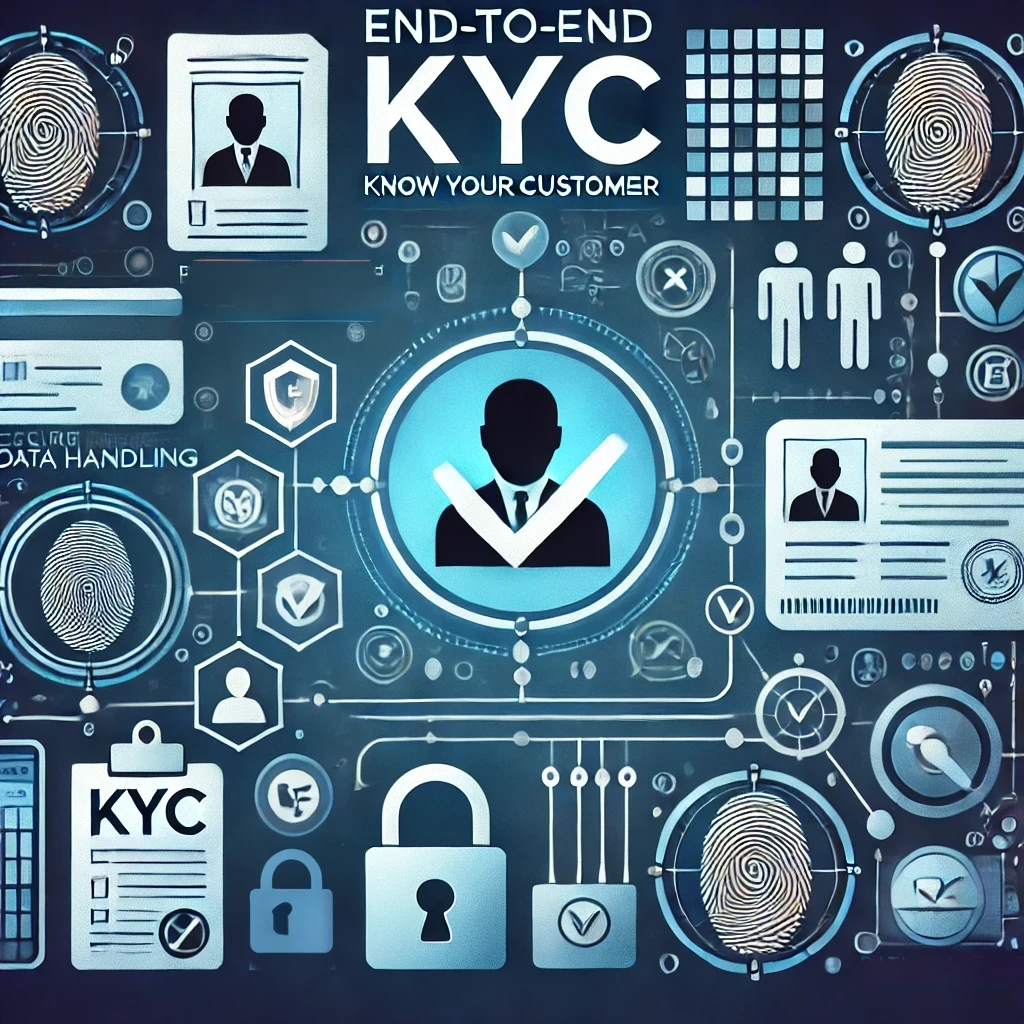Imagine a financial institution slapped with millions in fines because its KYC processes failed to detect fraudulent activities. This is not just hypothetical—regulatory bodies like AUSTRAC have imposed severe penalties on businesses that neglect robust KYC practices, leading to crippling financial and reputational damage.
As financial crimes become increasingly sophisticated, the stakes for effective KYC processes continue to rise. Implementing strong risk management in KYC is not just about compliance—it’s about protecting your institution from significant financial and operational risks.
In this article, we will explore the various types of risks associated with KYC, and more importantly, how to effectively mitigate them. By understanding and applying the strategies outlined, financial institutions can enhance their KYC processes, ensuring both compliance and security in an ever-evolving regulatory landscape.
Understanding the Types of Risk in KYC
Effective KYC processes are crucial for financial institutions to manage various risks that could jeopardise their operations. These risks can arise from regulatory non-compliance, operational inefficiencies, and financial exposure due to insufficient customer due diligence. By understanding and addressing these risks, financial institutions can safeguard themselves against significant penalties, reputational damage, and financial losses. This section explores the key types of risks involved in KYC and why identifying high-risk scenarios is essential for robust risk management.
Regulatory Risk
Regulatory risk is one of the most pressing concerns for financial institutions, especially in today’s highly regulated environment. Non-compliance with KYC regulations can lead to severe consequences, including substantial fines, legal sanctions, and damage to an institution’s reputation. For example, regulatory bodies like AUSTRAC in Australia enforce stringent AML/CTF laws, and failure to comply can result in multimillion-dollar fines and restrictions on business activities. For institutions that operate globally, navigating the complex web of regulations across different jurisdictions further amplifies this risk. Ensuring compliance through rigorous KYC processes is therefore vital to avoiding these potentially crippling outcomes.
Operational Risk
Operational risk in KYC processes arises from the potential for inefficiencies or errors that can compromise the effectiveness of customer verification. Common issues include false positives, where legitimate customers are flagged as risks, and false negatives, where actual risks go undetected. Such errors can lead to unnecessary delays, impacting customer satisfaction and potentially allowing fraudulent activities to slip through the cracks. For financial institutions, operational risk is often exacerbated by inadequate or outdated technology, insufficient training, or a lack of integration between different KYC systems. Addressing this risk requires a combination of robust technology solutions and continuous staff training, ensuring that processes are both efficient and accurate.
Financial Risk
Financial risk in KYC processes is closely linked to the potential for financial losses due to inadequate customer due diligence. If an institution fails to properly vet a customer, it may unknowingly facilitate money laundering, fraud, or other financial crimes. This can result in significant financial penalties, as well as losses from fraudulent transactions. Moreover, poor due diligence can damage investor confidence and lead to a decline in market value. For institutions with a strong focus on risk management, as highlighted in your customer persona, robust KYC processes are essential to safeguarding against these financial risks, ensuring that all customer interactions are thoroughly vetted and monitored.
Identifying High-Risk Scenarios
Certain sectors and types of customers inherently pose higher risks, requiring more stringent KYC processes. Industries such as online gambling, cryptocurrency exchanges, and international money transfers are particularly vulnerable to financial crimes, including money laundering and fraud. Additionally, customers who are politically exposed or operate in regions with lax regulatory oversight represent higher risk. In these high-risk scenarios, financial institutions must implement enhanced due diligence, continuous monitoring, and advanced verification tools to effectively manage and mitigate risks. By proactively identifying and addressing these high-risk scenarios, financial institutions can better protect themselves from regulatory penalties and financial losses.
Strategies for Effective KYC Risk Mitigation
To mitigate the risks associated with KYC processes, financial institutions must implement comprehensive and robust strategies. These strategies should include setting up a multi-layered verification process, conducting regular audits, continuous staff training, and leveraging advanced tools and technologies to ensure both efficiency and compliance.
Implementing Robust KYC Procedures
Implementing robust KYC procedures is foundational to mitigating risks and ensuring compliance in financial institutions. A well-structured KYC framework involves several key steps that work together to minimise risks associated with customer onboarding and ongoing monitoring.
How to Set Up a Multi-Layered Verification Process to Minimise Risks: A multi-layered verification process is essential for reducing the risk of errors and fraud in KYC. This approach involves multiple levels of checks and validations, ensuring that each customer’s identity is thoroughly verified from various angles.
- Initial Data Verification: Start with basic checks, such as verifying the customer’s identity through government-issued documents like passports or driver’s licenses. This step ensures that the individual or entity is who they claim to be.
- Cross-Referencing Data: Next, cross-reference the information provided with independent and authoritative databases, such as credit bureaus, social media, and government records. This step helps to confirm the accuracy of the data and detect any discrepancies.
- Continuous Monitoring: Even after the initial onboarding, continuous monitoring is crucial. This includes ongoing checks for any changes in customer profiles, such as updates in address or contact information, or any newly flagged risks like involvement in suspicious activities.
By layering these verification steps, financial institutions can significantly reduce the likelihood of onboarding fraudulent individuals or entities, thereby safeguarding against financial crime and ensuring compliance with regulatory requirements.
The Importance of Regular Audits and Continuous Staff Training: Regular audits and staff training are critical components of a robust KYC strategy.
- Audits: Conducting regular internal and external audits ensures that the KYC processes remain compliant with evolving regulations and that any gaps or inefficiencies are identified and addressed promptly. Audits also help in maintaining the integrity of the verification process, ensuring that each step is followed accurately and consistently.
- Staff Training: Continuous training for staff involved in KYC processes is essential. As regulations change and new threats emerge, it’s vital that staff are up-to-date with the latest best practices, technologies, and regulatory requirements. Training programs should include both the technical aspects of KYC processes and the soft skills necessary for making informed judgements during customer verification.
Practical Tools and Technologies:
To effectively mitigate KYC risks, leveraging the right tools and technologies is crucial. These tools can automate parts of the verification process, improve accuracy, and reduce the time required for customer onboarding.
- KYC Platforms: Tools that provide detailed consumer insights can help identify patterns and anomalies in customer supplied identity data that may indicate fraudulent activities. For example, Global Data’s Caspar platform offers detailed background checks and risk assessments. By accessing a wide range of consumer data, Caspar enhances the accuracy of KYC processes, making it easier to identify potential risks and ensure compliance with regulations.
- Automated IDV Systems: Automated systems like IDFEX ID Check streamline identity verification by integrating with authoritative databases such as the Australian Document Verification Service (DVS). This ensures that documents and identities are authenticated quickly and securely, reducing the risk of human error.
- Real-Time Monitoring and Alerts: Systems like WatchEye provide real-time monitoring of transactions and customer data, alerting institutions to any suspicious activities immediately. This allows for swift action and helps prevent potential financial crimes before they escalate.
By integrating these practical tools and technologies into their KYC processes, financial institutions can enhance both the efficiency and reliability of their operations. This not only helps in maintaining compliance but also in protecting the institution from the risks associated with financial crimes.
Enhancing Data Accuracy in KYC to Minimise Risk
Data accuracy is a critical component of KYC processes, directly influencing the effectiveness of customer verification and risk management. Inaccurate or incomplete data can lead to significant risks, including financial loss and regulatory penalties. Therefore, ensuring the integrity of customer data through validation, cross-verification, and leveraging advanced technologies is essential for minimising risk and maintaining compliance.
Importance of Data Integrity:
Data integrity is vital in KYC processes because the accuracy of the information used determines the reliability of the verification and risk assessment outcomes. Validating data from multiple sources is crucial to ensure that the information provided by customers is accurate, up-to-date, and complete. Relying on a single source can lead to errors, such as outdated information or missed red flags, which could expose the institution to risks like fraud or non-compliance. By cross-referencing data across various independent and authoritative databases, financial institutions can confirm the accuracy of customer information, thus reducing the likelihood of errors and ensuring robust compliance.
Cross-Verification Techniques:
Cross-verification techniques are essential for maintaining the accuracy of customer data throughout the KYC process. These methods involve comparing customer information across multiple data sources to identify and correct discrepancies. For example:
- Database Cross-Referencing: This involves checking customer information against various databases, including credit bureaus, government records, and social media profiles. Any inconsistencies between these sources can signal potential risks that require further investigation.
- Document Verification: Verifying identity documents against official government databases, such as through the IDFEX ID Check system, ensures that the documents are legitimate and that the details provided match the official records. This step is crucial for preventing fraud and ensuring the authenticity of customer identities.
- Ongoing Monitoring: Cross-verification should continue even after the initial onboarding. Regularly updating and monitoring customer information helps institutions detect changes that could indicate new risks, such as a sudden change in address or unusual transaction patterns. Continuous cross-verification ensures that customer data remains accurate and reliable over time.
Leveraging Technology for Accuracy:
Technology plays a pivotal role in enhancing data accuracy within KYC processes. By automating verification tasks and providing real-time monitoring, advanced tools can significantly reduce errors and help identify patterns that might indicate risk.
- Reducing Errors with Automation: Automated systems, such as those powered by AI, can process vast amounts of data quickly and accurately, reducing the likelihood of human error. For instance, AI-driven tools can identify discrepancies in customer data or flag potentially fraudulent activities, enabling institutions to take timely and informed action.
- Identifying Risk Patterns with Real-Time Monitoring: Real-time monitoring tools, like the WatchEye platform, continuously track customer transactions and data changes. These tools provide instant alerts for suspicious activities, allowing financial institutions to respond quickly and mitigate potential risks. By continuously monitoring and analysing data, these systems can identify emerging risk patterns that may not be immediately apparent through manual processes.
By integrating these approaches, financial institutions can significantly enhance the accuracy and reliability of their KYC processes, reducing risk and ensuring compliance with regulatory requirements. This not only protects the institution from financial crime but also builds trust with customers by ensuring that their information is securely and accurately managed.
Integrating Technology and Human Oversight
AI is currently a hot topic in KYC, thanks to its ability to quickly analyse large datasets and flag potential risks. However, while AI can significantly enhance efficiency, it’s important to remember that it should not replace human judgement. Human oversight is essential for interpreting complex situations, making ethical decisions, and providing final verification. Technology, including AI, should serve as a powerful tool to support, rather than replace, human involvement, ensuring both accuracy and ethical integrity in KYC processes.
Balancing Automation with Human Insight
Automation has transformed KYC processes, enabling institutions to manage large volumes of data and streamline routine tasks. However, even as technology takes on these roles, human insight remains irreplaceable. Machines can process information, but they lack the nuanced understanding that comes with human experience. By balancing automation with human judgement, financial institutions can ensure that their KYC processes are both efficient and capable of addressing complex, context-specific issues.
Using Technology Tools Effectively
To enhance the effectiveness of KYC processes, financial institutions should leverage advanced tools that streamline and improve verification and monitoring tasks. Global Data offers several key solutions tailored to meet these needs:
- Caspar KYC Platform: Caspar is a solution tailored for efficient KYC operations. It enables financial institutions to perform in-depth background checks, risk assessments, and identity verifications using a broad range of consumer data. Caspar’s ability to integrate with various data sources allows institutions to manage customer information with precision, ensuring compliance with KYC regulations and reducing the risk of financial crime. The platform also supports features like court searches, business checks, and social media verifications, making it a versatile tool for thorough due diligence.
- WatchEye Monitoring System: WatchEye is designed to provide real-time monitoring and alerting for critical data points. This tool is particularly effective for financial transaction monitoring, where it helps detect and report suspicious activities in compliance with AUSTRAC requirements. WatchEye also offers PEPs and sanctions screening, fraud detection, and customer file monitoring, allowing institutions to proactively manage risks. Its customisable alert system ensures that users are promptly informed of any significant changes, enabling quick responses to potential threats.
- IDFEX ID Check: IDFEX enhances the identity verification process by integrating with Australia’s Document Verification Service (DVS) to validate key identity documents like passports and driver’s licenses. This tool is not only effective in verifying identities during the onboarding process but also plays a crucial role in ongoing compliance. IDFEX allows for the verification of multiple data points, including names, addresses, phone numbers, and even social media profiles, providing a comprehensive view that aids in both fraud prevention and risk reduction.
By integrating these tools into their KYC processes, financial institutions can significantly improve accuracy, reduce manual workload, and ensure compliance with regulatory standards. Proper use of these technologies allows for more efficient and secure operations, safeguarding institutions against financial crime and reputational risks.
Industry Collaboration for Risk Mitigation
The fight against financial crime is not one that institutions can win alone. Collaboration within the industry is essential for strengthening KYC processes. By sharing intelligence, best practices, and threat information, financial institutions can better identify and mitigate risks. This collective effort also promotes the standardisation of KYC practices, helping to protect the broader financial ecosystem. Partnering with regulators, peers, and technology providers ensures that risk mitigation strategies are robust and up-to-date.
Conclusion
In today’s complex regulatory environment, a comprehensive approach to KYC risk management is essential for financial institutions to safeguard themselves against financial crimes and ensure compliance. Throughout this article, we’ve explored the importance of understanding the various types of risks in KYC processes, implementing robust procedures, enhancing data accuracy, and leveraging technology effectively. Each of these components plays a critical role in reducing the likelihood of errors, improving the efficiency of KYC processes, and maintaining the integrity of customer data.
Recap Key Takeaways
- Understanding KYC Risks: Recognising and addressing the different types of risks—regulatory, operational, and financial—is crucial. High-risk scenarios require more stringent KYC processes to mitigate potential threats effectively.
- Implementing Robust Procedures: A multi-layered verification process, supported by regular audits and continuous staff training, is key to building a strong foundation for KYC processes.
- Enhancing Data Accuracy: Ensuring data integrity through cross-verification techniques and leveraging advanced technology is vital for accurate customer verification and risk management.
- Leveraging Technology: Tools like AI and real-time monitoring systems are invaluable in reducing errors and identifying patterns that indicate risk, making KYC processes more efficient and reliable.
Actionable Steps
To immediately enhance your KYC risk management, consider the following checklist:
- Conduct a Risk Assessment: Identify and prioritise the key risks in your current KYC processes.
- Implement a Multi-Layered Verification System: Ensure that your verification processes include multiple layers of checks, from initial data validation to ongoing monitoring.
- Regularly Audit KYC Processes: Schedule regular audits to identify gaps and inefficiencies in your KYC procedures.
- Invest in Staff Training: Provide continuous training for your team to keep them updated on the latest KYC best practices and regulatory requirements.
- Adopt Advanced Technology: Integrate AI-driven tools and real-time monitoring systems to enhance data accuracy and improve risk detection.
- Collaborate Across the Industry: Engage with industry peers, regulators, and technology providers to stay informed about emerging threats and best practices.
Looking Forward
As the regulatory landscape continues to evolve, financial institutions must stay ahead by adopting emerging technologies and adapting to new regulations. The future of KYC risk management will likely see increased reliance on AI and machine learning to automate complex tasks, as well as greater emphasis on real-time data analytics for proactive risk management. Additionally, ongoing collaboration within the industry will be crucial for developing standardised practices and improving the overall security of the financial ecosystem. By staying informed and agile, institutions can not only meet regulatory requirements but also enhance their resilience against financial crime.



